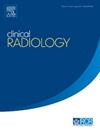深度学习在结直肠癌患者CT扫描分期中的肝脏病变分割与分类:一项多站点技术验证研究
IF 2.1
3区 医学
Q2 RADIOLOGY, NUCLEAR MEDICINE & MEDICAL IMAGING
引用次数: 0
摘要
目的:验证一种利用分期CT扫描对结直肠癌(CRC)患者肝脏病变进行检测和分类的模型。材料与方法基于unet的深度学习模型在2014-2019年的272张公共肝肿瘤CT扫描上进行了训练,并在同一家机构获得的220张CRC分期CT上进行了测试。性能指标包括病灶大小(10毫米、10 - 20毫米、20毫米)的检出率、分割精度(骰子相似系数,DSC)、体积测量一致性(Bland-Altman一致限,LOAs;类内相关系数(ICC),以及患者和病变水平(仅检测到的病变)的分类准确性(恶性与良性)。结果在884个病灶中,该模型的检出率为743个(84%),其中10 mm、10 - 20 mm和20 mm病灶的检出率分别为75%、91.3%和96%。10 mm的中位DSC为0.76 (95% CI: 0.72-0.80), 10 - 20 mm的中位DSC为0.83 (95% CI: 0.79-0.86), 20 mm的中位DSC为0.85 (95% CI: 0.82-0.88)。Bland-Altman分析显示,平均体积偏差为-0.12 cm3 (LOAs: -1.68至+1.43 cm3), ICC为0.81。病变分级敏感性99.5%,特异性65.7%,阳性预测值(PPV) 53.8%,阴性预测值(NPV) 99.7%,准确率75.4%。患者水平分类的敏感性为100%,特异性为27.1%,PPV为59.2%,NPV为100%,准确率为64.5%。结论该模型具有较强的病灶检测和分割性能,特别是对亚厘米级的病灶。虽然分类准确性中等,但100%的净现值显示了作为CRC分期筛查工具的强大潜力。未来的研究将评估其对放射科医生的表现和效率的影响。本文章由计算机程序翻译,如有差异,请以英文原文为准。
Deep learning for liver lesion segmentation and classification on staging CT scans of colorectal cancer patients: a multi-site technical validation study
AIM
To validate a liver lesion detection and classification model using staging computed tomography (CT) scans of colorectal cancer (CRC) patients.
MATERIALS AND METHODS
A UNet-based deep learning model was trained on 272 public liver tumour CT scans and tested on 220 CRC staging CTs acquired from a single institution (2014–2019). Performance metrics included lesion detection rates by size (<10 mm, 10–20 mm, >20 mm), segmentation accuracy (dice similarity coefficient, DSC), volume measurement agreement (Bland–Altman limits of agreement, LOAs; intraclass correlation coefficient, ICC), and classification accuracy (malignant vs benign) at patient and lesion levels (detected lesions only).
RESULTS
The model detected 743 out of 884 lesions (84%), with detection rates of 75%, 91.3%, and 96% for lesions <10 mm, 10–20 mm, and >20 mm, respectively. The median DSC was 0.76 (95% CI: 0.72–0.80) for lesions <10 mm, 0.83 (95% CI: 0.79–0.86) for 10–20 mm, and 0.85 (95% CI: 0.82–0.88) for >20 mm. Bland–Altman analysis showed a mean volume bias of -0.12 cm3 (LOAs: -1.68 to +1.43 cm3), and ICC was 0.81. Lesion-level classification showed 99.5% sensitivity, 65.7% specificity, 53.8% positive predictive value (PPV), 99.7% negative predictive value (NPV), and 75.4% accuracy. Patient-level classification had 100% sensitivity, 27.1% specificity, 59.2% PPV, 100% NPV, and 64.5% accuracy.
CONCLUSION
The model demonstrates strong lesion detection and segmentation performance, particularly for sub-centimetre lesions. Although classification accuracy was moderate, the 100% NPV suggests strong potential as a CRC staging screening tool. Future studies will assess its impact on radiologist performance and efficiency.
求助全文
通过发布文献求助,成功后即可免费获取论文全文。
去求助
来源期刊

Clinical radiology
医学-核医学
CiteScore
4.70
自引率
3.80%
发文量
528
审稿时长
76 days
期刊介绍:
Clinical Radiology is published by Elsevier on behalf of The Royal College of Radiologists. Clinical Radiology is an International Journal bringing you original research, editorials and review articles on all aspects of diagnostic imaging, including:
• Computed tomography
• Magnetic resonance imaging
• Ultrasonography
• Digital radiology
• Interventional radiology
• Radiography
• Nuclear medicine
Papers on radiological protection, quality assurance, audit in radiology and matters relating to radiological training and education are also included. In addition, each issue contains correspondence, book reviews and notices of forthcoming events.
 求助内容:
求助内容: 应助结果提醒方式:
应助结果提醒方式:


